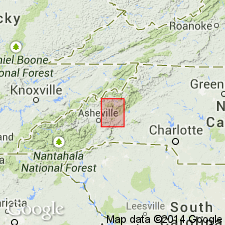
- Usage in publication:
-
- Henderson granite*
- Modifications:
-
- Original reference
- Dominant lithology:
-
- Granite
- Gneiss
- AAPG geologic province:
-
- Piedmont-Blue Ridge province
Summary:
Pg. 4. Henderson granite. Composed mainly of orthoclase and plagioclase feldspar, quartz, muscovite, and biotite, enumerated in order of importance. Intrusive into all Archean rocks with which it comes in contact. On east it extends only short distance beyond Mount Mitchell quadrangle into adjoining Morganton quadrangle, but toward southwest it increases greatly in width and reaches far into South Carolina. Assigned to Archean.
[Named from extensive areas and exposures in Henderson Co., western NC.]
Source: US geologic names lexicon (USGS Bull. 896, p. 940).
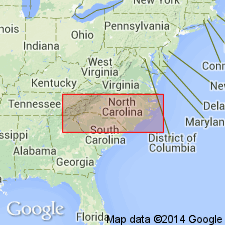
- Usage in publication:
-
- Henderson granite gneiss
- Modifications:
-
- Mapped
- AAPG geologic province:
-
- Piedmont-Blue Ridge province
Summary:
Pg. 16-17; J.L Stuckey, 1958, Geol. Map of North Carolina, scale 1:500,000. As mapped, Henderson granite gneiss unit is essentially Henderson granite as named and described by Keith (1905) and further described by Keith (1907, USGS Geol. Atlas, Folio 143). Recently the Henderson has been mapped to near Linville Falls, McDowell County, where it makes contact with what is considered southern extension of Cranberry granite. Both units are considered to be metasedimentary in origin and stratigraphically equivalent. Henderson composed essentially of rocks with pronounced gneissoid structure. Mapped as Precambrian(?) .
Source: US geologic names lexicon (USGS Bull. 1200, p. 1731).
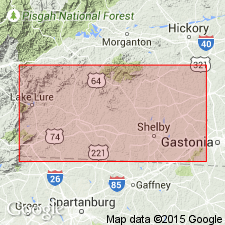
- Usage in publication:
-
- Henderson granite
- Modifications:
-
- Geochronologic dating
- AAPG geologic province:
-
- Piedmont-Blue Ridge province
Summary:
Pg. 115. Henderson granite. Paleozoic on basis of Lead-alpha age determination.
[GNC remark (ca. 1960, US geologic names lexicon, USGS Bull. 1200, p. 1731): The USGS currently designates the age of the Henderson gneiss as Ordovician to Devonian on the basis of a study now in progress. (See Overstreet and Bell, 1965.)]
Source: Publication; US geologic names lexicon (USGS Bull. 1200, p. 1731).

- Usage in publication:
-
- Henderson Gneiss*
- Modifications:
-
- Redescribed
- AAPG geologic province:
-
- Piedmont-Blue Ridge province
Summary:
Pg. B28-B29, pl. 2. Henderson Gneiss. Fine- to medium-grained strongly foliated and lineated biotite-quartz monzonite gneiss. Commonly contains augen of feldspar jacketed by quartz and plagioclase and strongly aligned parallel to lineation. Age is Precambrian and/or Early Paleozoic.
Source: Publication; GNC index card files (USGS-Reston).
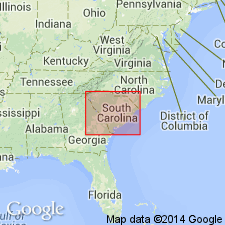
- Usage in publication:
-
- Henderson Gneiss*
- Modifications:
-
- Age modified
- Geochronologic dating
- AAPG geologic province:
-
- Piedmont-Blue Ridge province
Summary:
Pg. 63-64, 74, 89 (geol. time scale), 92 (table 7), 94 (table 8), 98 (table 9), 103-104. Henderson Gneiss. Age changed from Precambrian or early Paleozoic --to-- Ordovician to Devonian on basis of Lead-alpha age determination. (Authors follow revised time scale of Holmes, 1959, Edinburgh Geol. Soc. Trans., v. 17, pt. 3, p. 183-216.)
Source: Publication; Changes in stratigraphic nomenclature, 1964 (USGS Bull. 1224-A, p. A18).
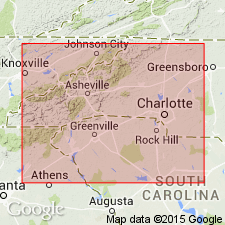
- Usage in publication:
-
- Henderson Gneiss*
- Modifications:
-
- Revised
- AAPG geologic province:
-
- Piedmont-Blue Ridge province
Summary:
Authors recommend that the name Henderson Gneiss be restricted to orthogneiss equivalent to that interpreted as Cambrian in age in the type area. Rocks mapped as Henderson Gneiss northeast of the Keowee River are identical and continuous with those in the type area, but other augen gneisses in the Chauga belt, southwest of the Keowee River, SC, should not be called Henderson as they have smaller augen and grade into and are interlayered with equigranular quartzofeldspathic gneiss or feldspathic quartzite. Quartz-feldspar-mica gneiss just south of Sauratown Mountains anticlinorium near Call, NC, formerly mapped as Henderson, but subsequently shown to be younger (460+/-9 Ma) by Harper and Fullagar (1981) belongs to the Table Rock Plutonic Suite (new name).
Source: GNU records (USGS DDS-6; Reston GNULEX).
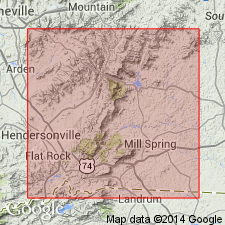
- Usage in publication:
-
- Henderson Gneiss
- Modifications:
-
- Areal extent
- AAPG geologic province:
-
- Piedmont-Blue Ridge province
Summary:
Davis (1993: Univ. of TN, Ph.D. dissertation) redefined the lithostratigraphy of the Columbus Promontory to include four major units including the Henderson Gneiss, the Sugarloaf gneiss, the Poor Mountain Formation, and the Mill Spring complex. New framework is consistent in many ways with original ideas of Lemmon (1973). These units comprise three thrust sheets. The 509 Ma Henderson Gneiss and a 438 Ma granitoid intruded into the Henderson are contained in the Tumblebug Creek thrust sheet. The Henderson, according to Reed and Bryant (1964) extends from the SC-GA border northeastward to the southeastern flank of the Grandfather Mountain window. The most extensive exposure within the Promontory occur in the Fruitland, Bat Cave, Hendersonville, Lake Lure and the NW corner of the Cliffield Mountain quads. Composition varies from that of granite to quartz monzonite. Minerals include microcline, oligoclase, quartz, and biotite with accessory muscovite, garnet, allanite, zircon, sphene, and opaques. One of the most distinctive characteristics is the presence of K-feldspar augen up to 3 cm long. Henderson has undergone many geochronological studies, but many discrepancies exist. 509 Ma date used in this report is from Sinha and others (1989) recalculated from Odom and Fullagar (1973).
Source: GNU records (USGS DDS-6; Reston GNULEX).
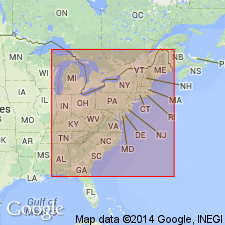
- Usage in publication:
-
- Henderson Gneiss*
- Modifications:
-
- Geochronologic dating
- AAPG geologic province:
-
- Piedmont-Blue Ridge province
Summary:
Cambrian age for Henderson Gneiss is based on Rb-Sr whole-rock age of 525+/-27 Ma (Odom and Fullagar, 1973) and a Pb-Pb zircon age of 593 Ma (Sinha and Glover, 1978).
Source: GNU records (USGS DDS-6; Reston GNULEX).
For more information, please contact Nancy Stamm, Geologic Names Committee Secretary.
Asterisk (*) indicates published by U.S. Geological Survey authors.
"No current usage" (†) implies that a name has been abandoned or has fallen into disuse. Former usage and, if known, replacement name given in parentheses ( ).
Slash (/) indicates name conflicts with nomenclatural guidelines (CSN, 1933; ACSN, 1961, 1970; NACSN, 1983, 2005, 2021). May be explained within brackets ([ ]).

